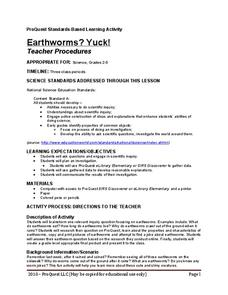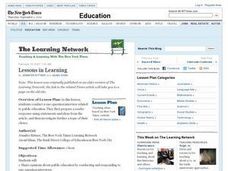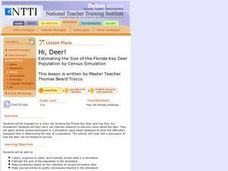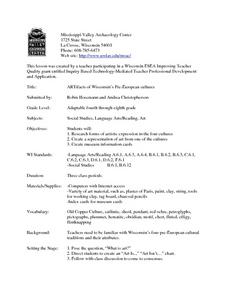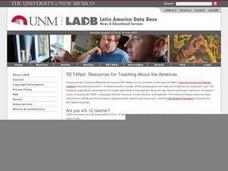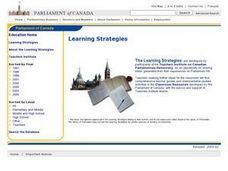Curated OER
Rooting One's Way To Meaning
Students use a thesaurus on the internet to explore the meanings of Greek and Latin roots. They find definitions of given words, draw a concept map for root words, and write four synonyms for each word. Students discover how Latin and...
Curated OER
We All Live Together
First graders examine the lifestyle of classroom and family pets in their natural habitat. They determine the needs of plants and animals, and how those needs are met. They listen to read alouds, sing songs, and draw using computer based...
Curated OER
Preprimer Word List
In this preprimer word list worksheet, learners color the words in the list and draw a line to connect matching words. Students do this for 10 words.
Curated OER
Conscience and Public Service
Students study conscientious observers (COs) in the Civilian Public Service (CPS) during World War II. They explore how the media sources influence public opinion and policy makers, and complete a writing assignment about the topic.
Curated OER
Unionism versus Secessionism in Virginia
Eleventh graders, in groups, analyze newspaper articles and then debate and discuss if Virginia should succeed from the Union or not.
Curated OER
World War II: America on the Home Front
Eleventh graders gain a sense of historical time and historical perspective as they study the massive campaign that the U.S. government launched to convince Americans to conserve, participate, and sacrifice. They study cencorship, and...
Curated OER
Lessons in Learning
Students share their opinions about public education by responding to one-question interviews. After reading an article, they discover new recommendations for the No Child Left Behind Act. They prepare a three-part reader response to...
Curated OER
Effigy Mound Activity
Students research effigy mounds of Native people in Wisconsin. They create large models of effigy mounds in a given area based on factual information from their studies and research.
Curated OER
Alice Computer Programming
Students explore multimedia components. In this science inquiry lesson, students read "Invitation to the Game" by Monica Hughes and they use the Alice Computer Programming System to better understand population dynamics.
Curated OER
Hi, Deer!
Students collect, organize by table, and examine census data in a simulation, estimate the size of the population in the simulation and make predictions based on the collection of census simulation data.
Curated OER
Inference By Analogy
Students infer the use or meaning of items recovered from a North Carolina Native American site based on 17th-century European settlers' accounts and illustration.
Curated OER
Artifacts of Wisconsin's Pre-european Cultures
Students research forms of artistic expression in four cultures. They create a representation of art from one of the cultures and create museum information cards. They develop a rubric to evaluate each others work.
Curated OER
Finding Science in An American Childhood by Annie Dillard
Students read excerpts from Annie Dillard's memoir, "An American Childhood," with the teacher. They experience opportunities to connect English, science, nature and art together from a new and unique perspective. This approach serves as...
Curated OER
Electronic Journals about Latin American Folktales
Students exchange folktales with a key-pal using dialog journal writing. They write out a folktale from their own cultural background and exchange it with students of another. They record their impressions of each other's folktales.
Curated OER
Historical Perspectives Through the Eyes of Young People
Learners gather knowledge about various roles of students in different cultures and eras. Learners research their choice of eras and create a personal artwork to express the tone of the selected era.
Curated OER
People of the Past
Young scholars investigate the four groups of people that existed in the U.S. before the European settlers arrived. They predict how the people arrived in the U.S., then investigate their predictions to find out whether or not they are...
Curated OER
Archeological Thinking
Sixth graders review the differences between a historian and archaeolgists. At a recent archaeological dig site, they examine the artifacts and determine their usage. In groups, they are given a bag full of artifacts and write down what...
Curated OER
Does This Belong to You?
Fourth graders examine legislation that has been passed to protect the rights and religion of Native Americans. In groups, they discuss their feelings on others taking artifacts from Native American sites and what they do if they find...
Curated OER
Invent on the Spot
The best inventions come from a problem that needs to be solved! Given a container with holes in it, learners must solve how to stop liquid from pouring out. They work together to develop an invention to accomplish this task.
Curated OER
Second Graders Create Their Own Social Studies Book (Part I, The 5Ws of the Constitution)
Students study the United States Constitution and create a year-long cumulative activity for social studies. In this social studies lesson, students complete activities throughout the year to learn the 5Ws for the United States...
Curated OER
Multiculturalism and Immigration
Tenth graders determine how a refugee is different from a migrant. They explain how there are various classifications of refugee claimants and gain an overview of Canada's refugee determination system.
Curated OER
Gridding a Site
Students establish a grid system over an archaelogical site. They label each grid unit. They determine the location of artifacts within each grid unit. They construct a scientific inquiry concerning the location of artifacts on the site.
Curated OER
Classification and Attributes
Students classify objects based on their attributes. They explain how archaeologists use classification to help answer research questions.
Curated OER
Streamlines and Breadlines
Students explore the Great Depression. In this Great Depression instructional activity, students research selected websites and analyze primary sources to conduct inquiries regarding the depression, northern migration, and urbanization....




